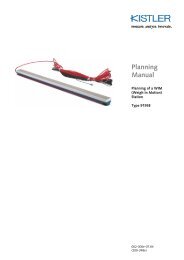Installation of Fixed Capacitive HSWIM Sensors
Installation of Fixed Capacitive HSWIM Sensors
Installation of Fixed Capacitive HSWIM Sensors
You also want an ePaper? Increase the reach of your titles
YUMPU automatically turns print PDFs into web optimized ePapers that Google loves.
Important notes<br />
Refer to the Mikros Systems loop installation document.<br />
The terms <strong>HSWIM</strong> (High Speed Weighing In Motion) and WIM (Weighing In Motion)<br />
are used interchangeably throughout this document.<br />
All procedures stipulated in the loop installation document are relevant to the<br />
installation <strong>of</strong> WIM sensors.<br />
Adhere to the required safety and quality assurance procedures.<br />
Install only on an adequate road surface.<br />
Consult a pavement specialist before deciding on the appropriate installation method.<br />
Install the width and the breadth <strong>of</strong> the sensor, level with and parallel to the road<br />
surface using the bottom <strong>of</strong> the frame as reference and not the frame sides.<br />
Set the frame 2-3mm below the pavement surface.<br />
Keep water from penetrating to the sub-base.<br />
Only use Mikros Systems supplied feeder wire.<br />
When positioning a sensor, make sure that the middle <strong>of</strong> the sensor coincides with a<br />
wheel track.<br />
Although this document refers mainly to the 2m WIM sensor al the same procedures<br />
are valid when installing a 1,5m sensor.<br />
Background information<br />
This document should be used in conjunction with “MS001-96200-52 <strong>Installation</strong> <strong>of</strong> Loops for<br />
Traffic Logging Stations”, which describes in detail the basics for any type and configuration<br />
<strong>of</strong> Traffic Logging installations. An in-depth knowledge <strong>of</strong> this document is a prerequisite.<br />
Site selection is the key factor in a successful High Speed Weighing-In-Motion (<strong>HSWIM</strong>)<br />
station installation and performance. For the requirements <strong>of</strong> a <strong>HSWIM</strong> site refer to the<br />
document “MS001-00005-41 WIM Site Requirements”.<br />
For a proper installation what is <strong>of</strong> utmost importance is:<br />
Pavement (road conditions)<br />
o Flatness (flushness)<br />
o Smoothness (riding quality)<br />
o Evenness (surface quality)<br />
Traffic behaviour<br />
o Uniform flow<br />
o Lane discipline<br />
To maintain these qualities <strong>of</strong> installation over a long term only high quality pavements <strong>of</strong><br />
ample thickness that are structurally sound should be selected. In lesser pavements the<br />
integrity <strong>of</strong> WIM data will be compromised. Mikros Systems cannot be held accountable for<br />
the poor performance <strong>of</strong> a WIM installation that is done in sub-standard conditions.<br />
Mikros Systems recommends that the user <strong>of</strong> <strong>HSWIM</strong> equipment also refers to the US<br />
Federal High Way Associations specification document for <strong>HSWIM</strong> systems, called “ASTM<br />
E1318-94 Standard Specification for Highway Weigh-In Motion (WIM) Systems with User<br />
Requirement and Test Method”.<br />
Figure 1 (see Annexure A) illustrates the general principle <strong>of</strong> installing a Mikros Systems<br />
<strong>Capacitive</strong> WIM Sensor.<br />
MS001-96100-52 <strong>Installation</strong> <strong>of</strong> <strong>Fixed</strong> <strong>Capacitive</strong> <strong>HSWIM</strong> <strong>Sensors</strong> Issue5 1 March 2005<br />
4 / 56
















